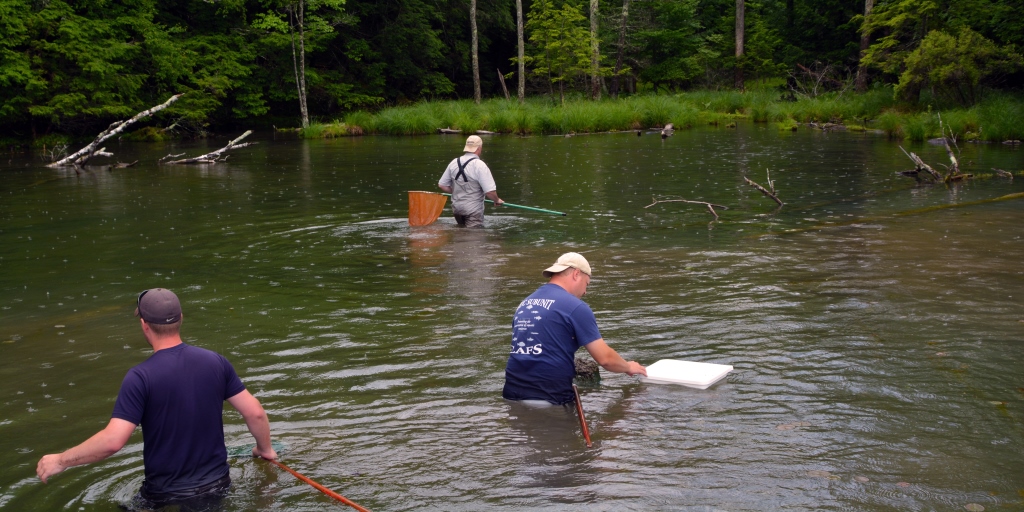Wiring food webs at Lake George
A collaborative project at Lake George, NY, merges sensory, experimental, and natural history data to develop a better model for environmental monitoring and prediction in lake ecosystems around the world.
Guest post by Matt Schuler, a 2013 ESA Graduate Student Policy Award winner currently working as postdoctoral researcher in Rick Relyea’s lab at Rensselaer Polytechnic Institute in Troy, NY.

Searching for snails. Author Matt Schuler (lower left), Rick Relyea (upper middle), and Bill Hintz (lower right) survey Lake George for invasive banded and Chinese mystery snails. Invertebrate surveys from Relyea’s group are part of a food web study that is measuring the complex interactions of the organisms living in Lake George, from the smallest plankton to the largest lake trout. Credit, Brian Mattes.
The clear waters of Lake George offer an unobstructed view of the claw-like Ponar Grab Sampler as it reaches the sandy lake bottom, 15 feet below our boat. Kelsey Sudol, an undergraduate from Rensselaer Polytechnic Institute (RPI) pulls sharply upward on the rope attached to the grab sampler, triggering a spring-loaded mechanism. The trap clamps shut around the soil and invertebrates that live in and on the soil, and she draws them to the surface. After we have separated mollusks, arthropods, and insect larvae from the soil with a sieve, this will be one of 30 samples taken from around the lake each month. We will use the data from these samples to understand how invertebrate biomass, diversity, and composition change across space and time. Our invertebrate surveys are part of a food web study that is measuring the complex interactions of the organisms living in Lake George, from the smallest plankton to the largest lake trout. However, measuring and modeling the food web of the 44-square-mile lake is only one component of the Jefferson Project at Lake George.

Sieving for small lake-dwelling animals. Schuler and student Cody VanDeLaarschot wash macroinvertebrates sampled from Lake George into a bag. Macroinvertebrates will be later sorted from the remaining sand and debris, and then will be identified, counted, and weighed. Credit, Lovisa Lind.
The Jefferson Project is a collaborative, interdisciplinary effort between RPI, IBM, and the FUND for Lake George. Researchers in ecology, engineering, computer science, and the arts and humanities – among other fields – are working together to build a better understanding of lake ecosystems around the world. The project combines new technologies, including an Internet of Things (IOT) computational platform, with observational and experimental data, in developing a new model for environmental monitoring and prediction. The IOT computer platform captures and analyzes abiotic data from a series of “smart” sensors located in and around the lake. The sensor data are combined with food web data and experimental data to form a comprehensive picture of how Lake George functions as a complex ecosystem. This new model can be emulated around the world, helping to redefine how we monitor ecosystems, understand the impact of human activities, and provide insight for the protection of freshwater resources.
These lofty goals would not be possible without 35 years of water quality and chemistry monitoring data collected by researchers at Rensselaer’s Darrin Freshwater Institute, with support from The FUND for Lake George. Those data indicate that the water quality of Lake George is changing – with noticeable increases in salt, algae, and invasive species – and humans are a likely cause of those changes.

Catch, measure, and release. Postdoctoral researcher Bill Hintz measures a lake trout captured in Lake George during a fish survey. After fish are captured, they are weighed and measured and then returned to the lake. Two species from each site are kept for gut content analysis, and to measure the amount of mercury in the muscle tissue. Credit, Matt Schuler.
Jefferson Project researchers are using trends from the 35-year study to design experiments targeted at understanding how human activities alter water quality and food web interactions in freshwater systems. Data from these experiments will help define mechanisms of how human-induced environmental effects like road salt, invasive species, and additional nutrients, change freshwater ecosystems. Over the past five months, in tandem with collecting food web data at Lake George, researchers collected data from over a dozen experiments conducted at the Rensselaer Aquatic Laboratory. To maintain relevance with the Jefferson Project, researchers filled hundreds of mesocosms with more than 50,000 gallons of water trucked from Lake George to Troy, NY. Results from these mesocosm studies will inform complex computer models and guide future experiments in the Lake George watershed, including in-lake mesocosm studies.

The mesocosm facility at Rensselaer Technology Park approaches the natural conditions of Lake George, in miniature, to allow experimental manipulation of lake characteristics. Credit, Brian Mattes.
Over the next few years, researchers working on the Jefferson Project will continue to survey the physics, chemistry, and biology of Lake George and conduct dozens of experiments to understand how humans alter freshwater ecosystems. These efforts would not be possible without the help of a comprehensive team from a variety of disciplines, and an army of undergraduates working with Jefferson Project researchers. Wielding the Ponar sampler, Kelsey is just one of 16 undergraduates who have worked on the Jefferson Project over the past year. By involving undergraduates from a variety of backgrounds and disciplines, we stress the importance of freshwater preservation and management. And, we are giving future scientists the tools and global perspective that will be needed to solve fresh water issues around the world.